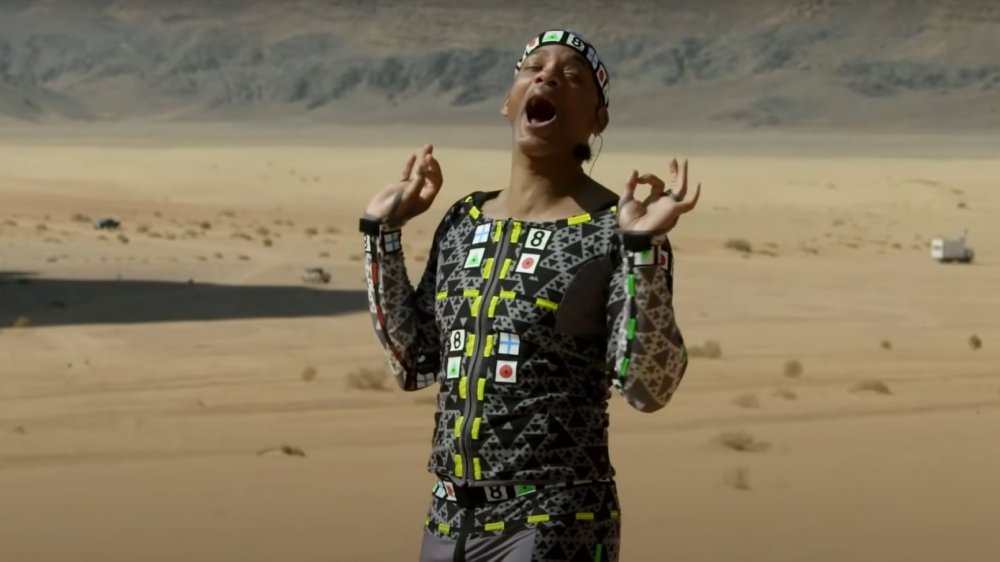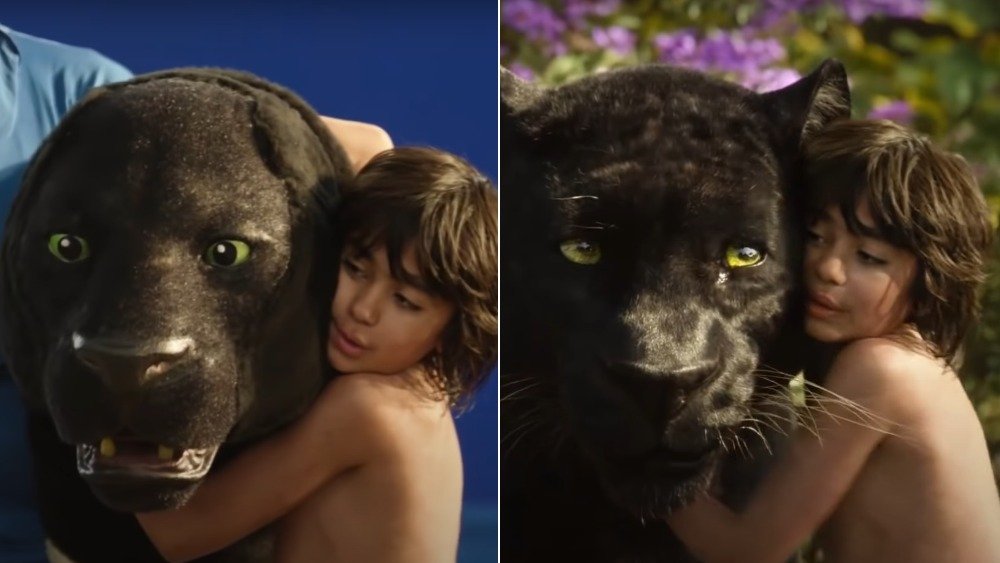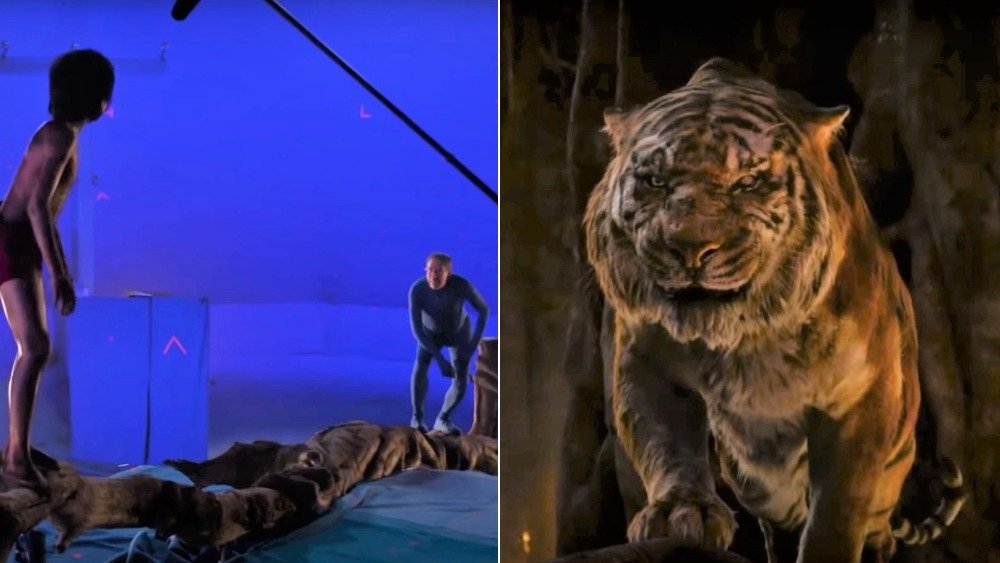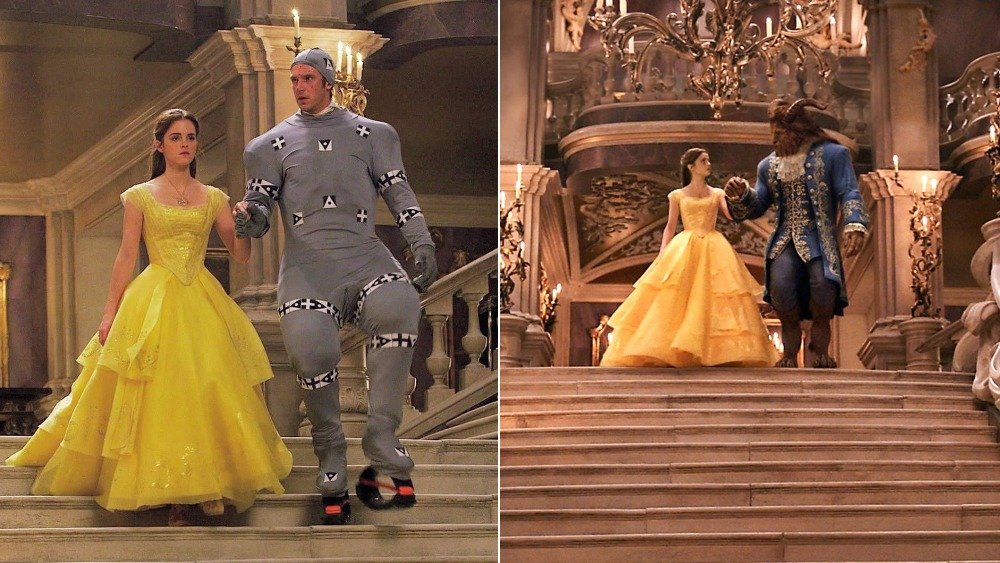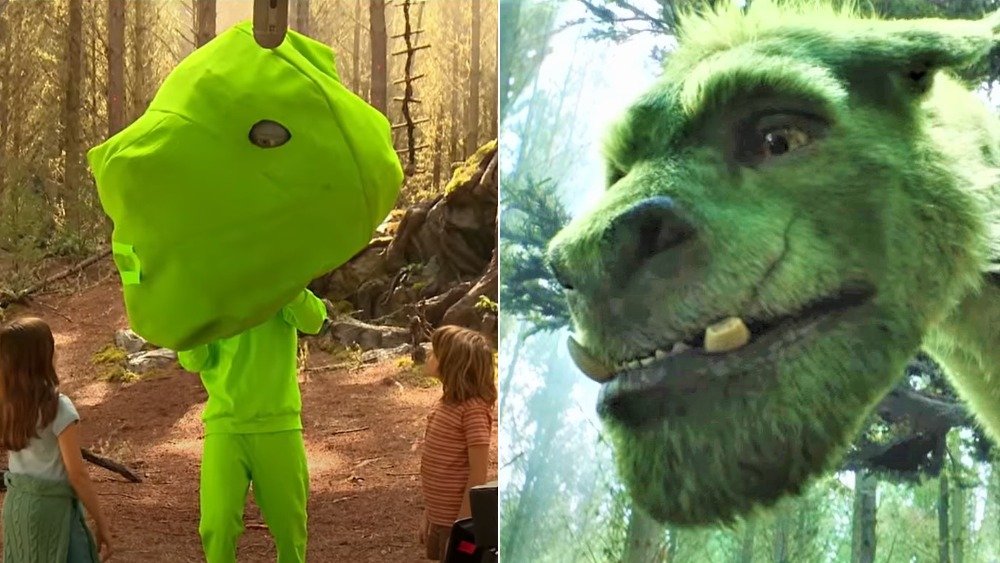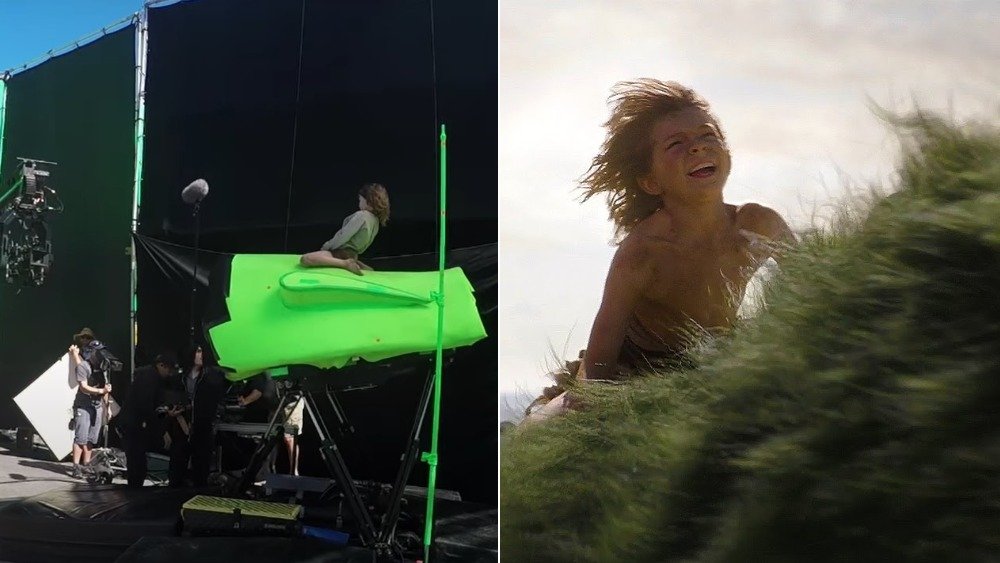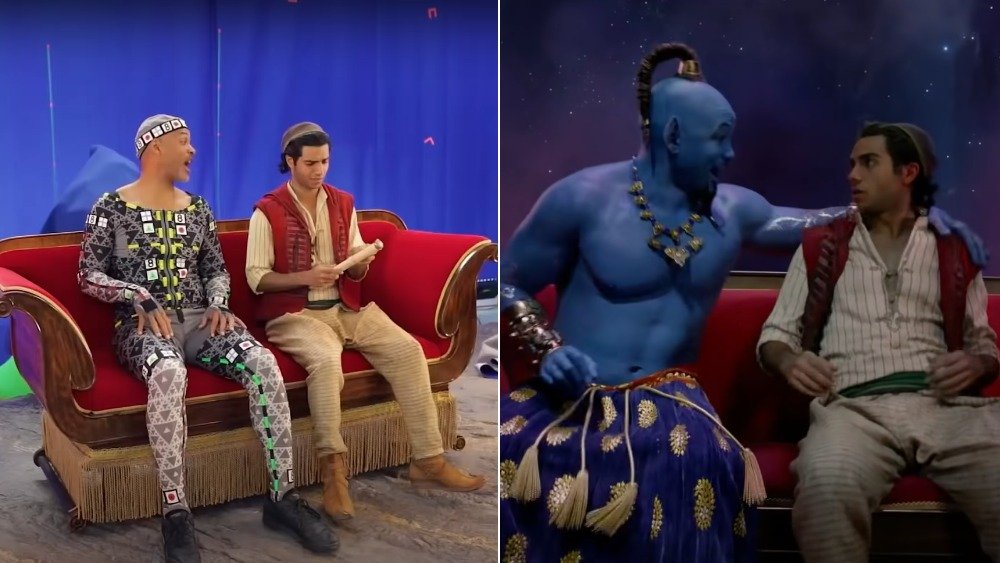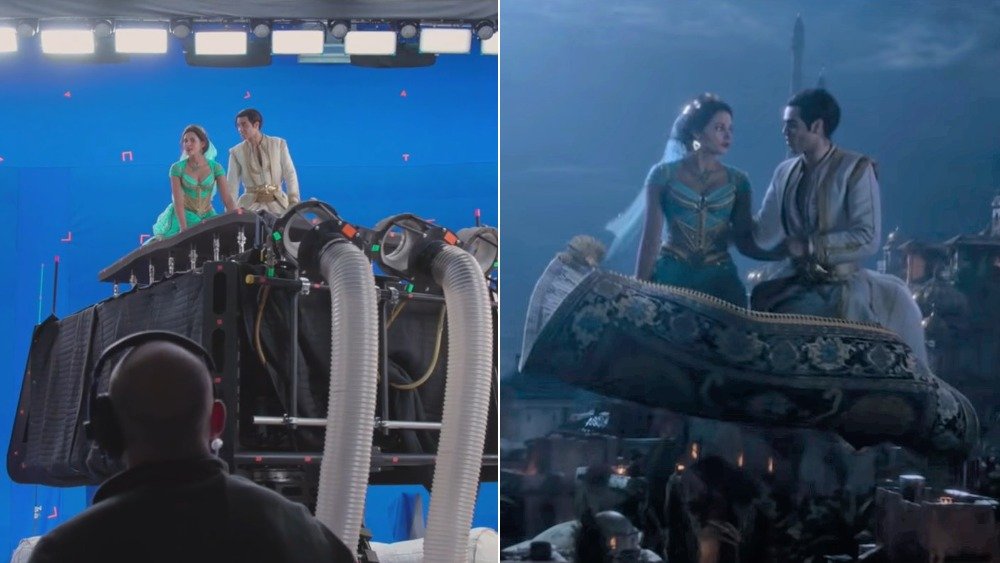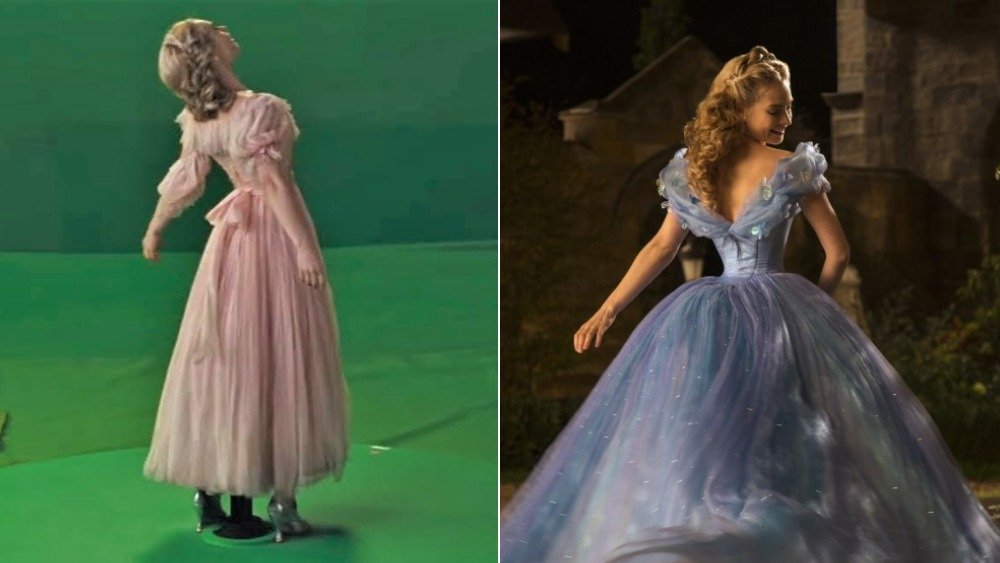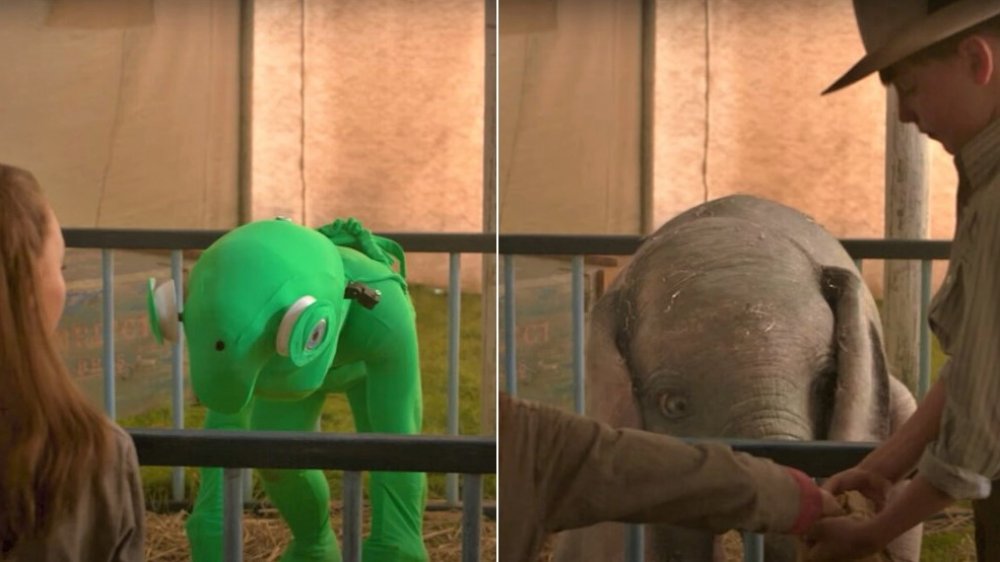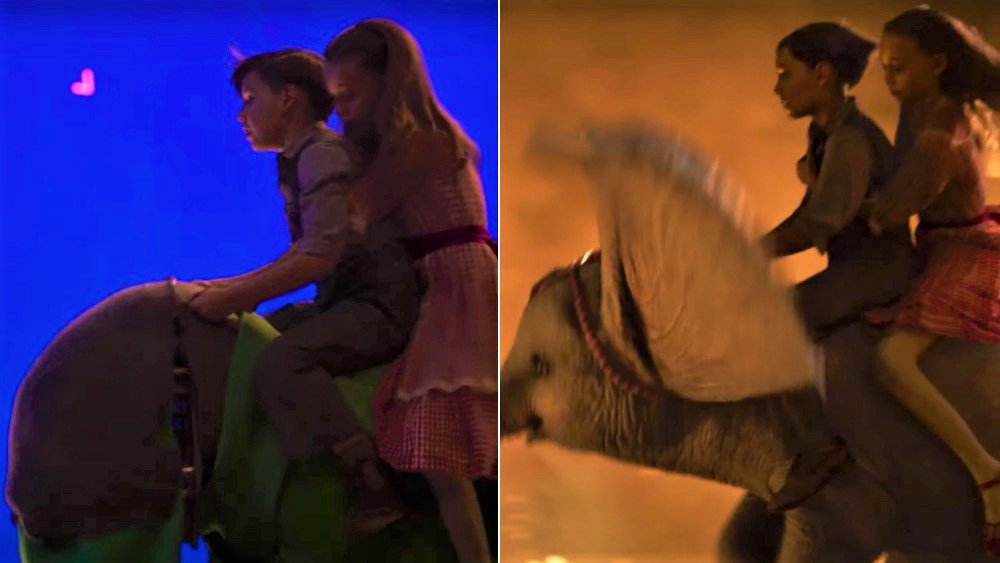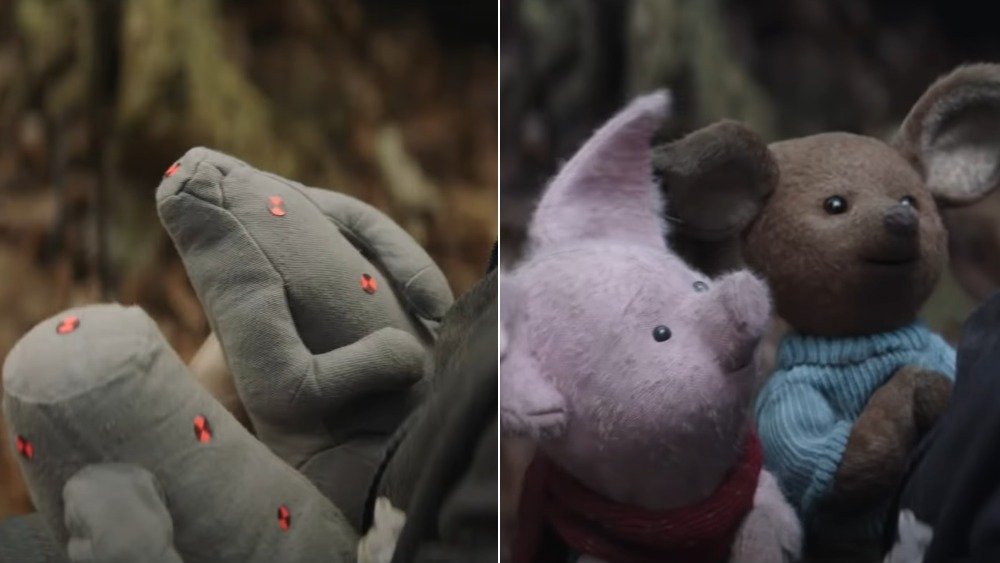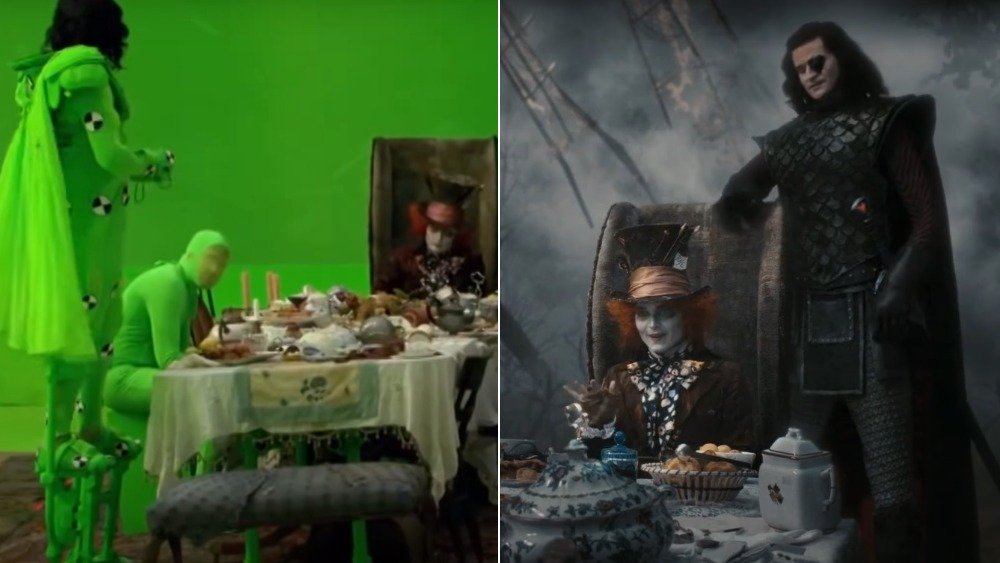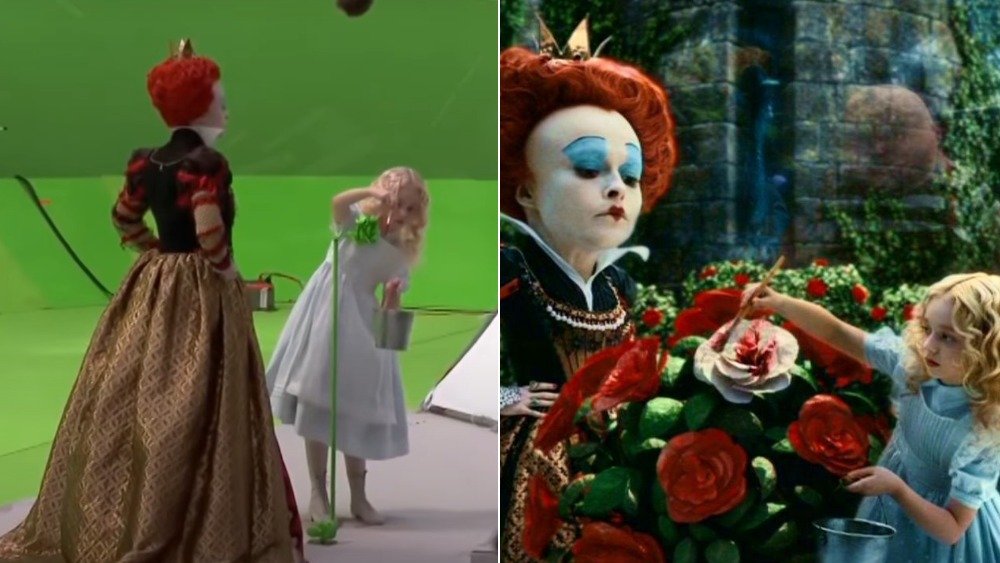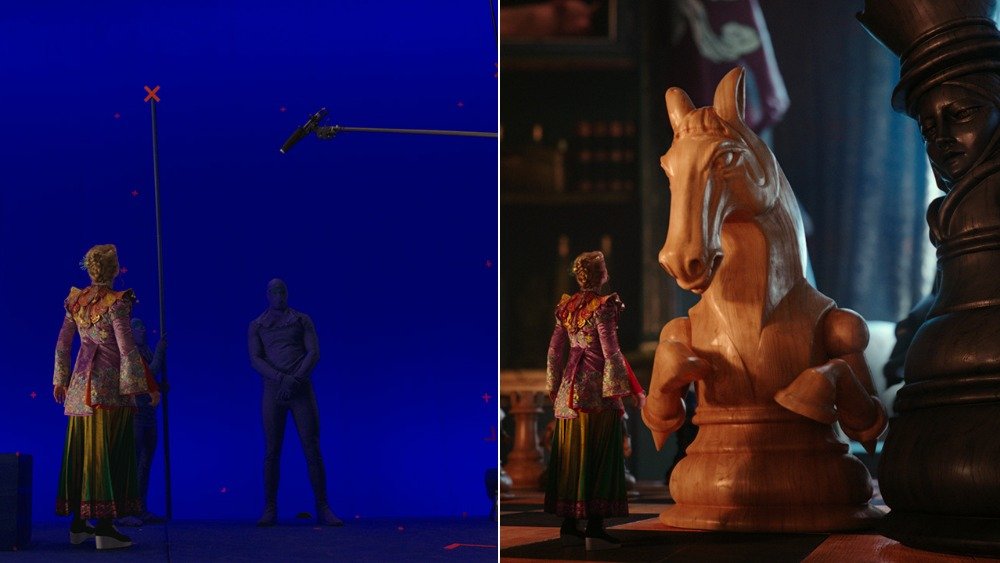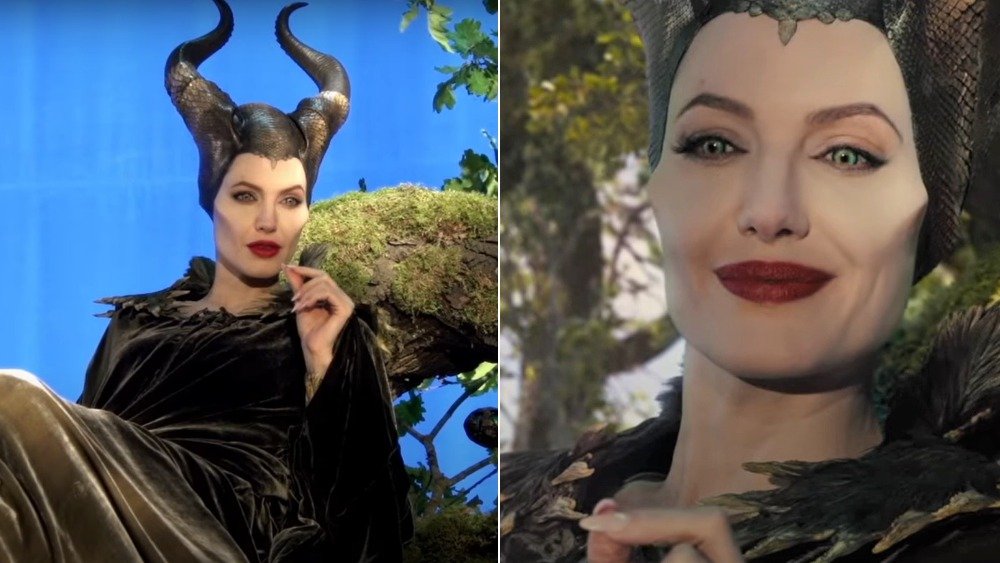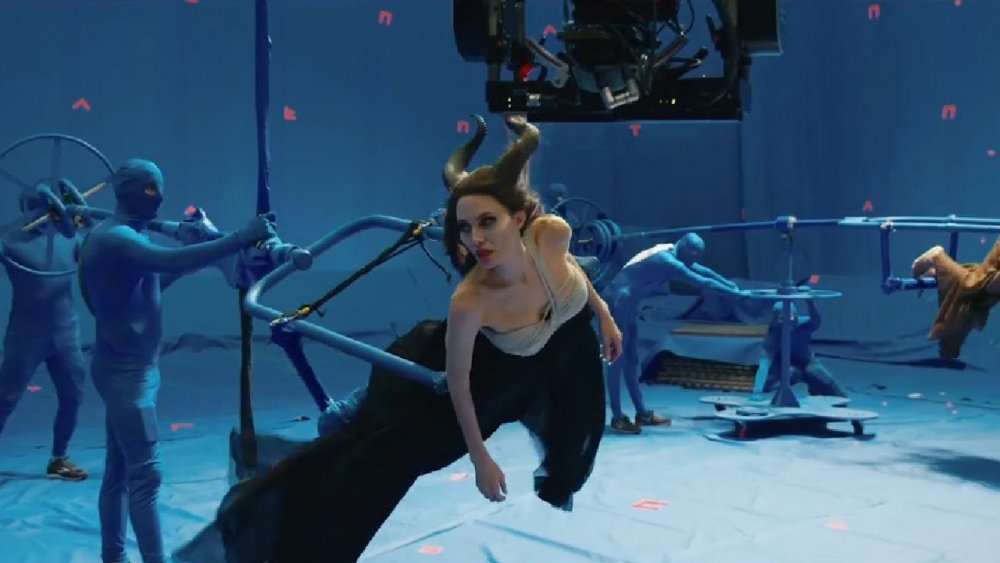What These Disney Live-Action Remakes Looked Like Before Special Effects
Much has been written about Hollywood's obsession with reboots and remakes, but a quick glance at Disney's box office receipts proves that there's most definitely an appetite for them. The studio's current spate of live-action re-imaginings began in 2010 with Tim Burton's Alice in Wonderland. That film made over $1 billion dollars at the worldwide box office, and several more big earners would follow – Disney had raked in a whopping $7 billion from its live-action remakes by summer 2019. Not all of them have joined the billion dollar club, but the one thing that these films do have in common is that they all rely heavily on visual effects.
Remaking an animated movie with real actors becomes tricky when there are genies and dragons involved, but it's all in a day's work for the people who turn green screens and motion capture suits into fantastical landscapes and iconic characters. The original footage is often totally unrecognizable by the time the VFX department is done working its magic, and when you peel away that CGI layer, it's usually as shocking as it is funny. Here's what the Disney live-action remakes looked like before special effects were added.
The Jungle Book was a "daunting" task
The visual effects wizards at MPC spent two long years building the wild, dense world of The Jungle Book, the vast majority of which was created digitally. "When they came to us wanting to do the movie with bluescreen and one kid, it was daunting," VFX supervisor Adam Valdez told Animation World Network. The company had a team from its Bangalore office visit 50 different jungle locations around India to conduct research. They came back with "hundreds of thousands" of reference photos, Valdez said. Photographers also captured plenty of animal footage for the visual effects team to work with, but creating the movie's photo-realistic animals wasn't even the hard part.
Making Bagheera and Baloo's interactions with Mowgli feel genuine was what would ultimately make or break Jon Favreau's live action remake of The Jungle Book, and the MPC team knew that all too well. "The guys in the rigging department spent many months developing and researching facial anatomy on big cats, wolves and bears, as well as how they move," Valdez revealed. In the end, it was an astute suggestion from the director that made all the difference. "Jon had this brilliant idea of using Jim Henson Company puppeteers to work with Neel Sethi, the actor who plays Mowgli, so that he always had a moving and engaging puppet," Valdez explained, adding: "A young person leaves that to the imagination and it came through."
The Jungle Book's VFX team spent a lot of time on 'delicate touches'
Making Mowgli's animal companions behave in a realistic way was always high on the agenda, but the visual effects artists working on The Jungle Book were also aware that a lot was riding on the appearance of the story's antagonist, Shere Khan. The human-hating tiger was just a guy in a blue leotard on set, but MPC's team of animators had to turn him into a fearsome villain. According to the company's VFX supervisor Adam Valdez, the challenge was creating animals that were capable of conveying emotion while still looking completely natural. "We can all relate to some things, like when a deer reacts with fright," he told Art of VFX. "We understand that, but how does a tiger sit down with intimidating attitude?"
Valdez and his team were on a "constant hunt" for references as they built Shere Khan (voiced by Idris Elba) from scratch. "Many clips of animal movements were found, recreated and then dialed into the shots," he said. "The animators spent a lot of time on the shots, adding delicate little touches." Of course, movement is only one aspect of making a convincing CGI animal, but Valdez was never that concerned about the fur. MPC has so much experience with rendering animals that the company has its very own proprietary tool, Furtility. "It's quite powerful and I think we have the best hair/fur in the business."
Beauty's Beast wasn't supposed to be CGI
Emma Watson became accustomed to working around CGI during her time in the Harry Potter series, but Beauty and the Beast still managed to introduce new challenges to the seasoned actress. To make it easier for director Bill Condon to get a grip on what was going on, Disney decided to make the experience as physical as possible. "We had the special effects team build some of the characters as animatronics, so they could actually be animated and moved around on set," VFX supervisor Kyle McCulloch told Deadline. "We had life-size builds of them that we could have on set, and then we had puppets."
The Beast was originally going to be achieved using practical effects. According to McCulloch, the two VFX vendors hired to work on the remake (Framestore and Digital Domain) discussed using a mixture of makeup and animatronics, but in the end, the "flexibility" of the CGI route was just too tempting. Plus, they needed to make sure that the "fidelity" of the actor's performance wasn't lost. By going digital, they would be able to take "all of the subtleties of what Dan Stevens was going to give us as the performer, and [see] all of that reflected in the Beast," McCulloch said. "If you were trying to do it under a thousand pounds of makeup, it was never going to give us the clarity of performance that Digital Domain ultimately achieved in the Beast."
Disney turned to the experts for Pete's Dragon
When Disney decided to remake 1977's Pete's Dragon, it turned to a vendor with a proven track record of bringing fantasy creatures to life: Weta Digital. Weta has created some of the most memorable CGI characters of all time, working with motion capture-savvy actor Andy Serkis on multiple occasions. Serkis won praise for his portrayal of evolved chimpanzee Caesar in the Planet of the Apes reboot series, and Weta took inspiration from that character when it came to making Pete's titular dragon, a.k.a Elliott. "With Caesar you really felt his pain and happiness, and with Elliot it's the same," Weta's Eric Saindon told The Hollywood Reporter. "The big challenge was getting the emotion out of Elliot. The connection between the dragon and Pete is such a big part of the film."
Unlike Caesar — and unlike Smaug, another famous Weta dragon — Elliott wasn't portrayed by an actor in a motion capture suit. "We had a green wire mesh head that I would lift over my head," Saindon recounted. "I tried to move the head as best I thought it would work for the shot, and then we'd track the head with our [CG] Elliot." This approach improved the performance of young star Oakes Fegley, who didn't mind acting opposite wire mesh heads and tennis balls on sticks the entire time. "It's actually kind of fun," he said.
Pete's dragon has 20 million individual hairs
Peter Jackson's King Kong won three Academy Awards in 2006, one of which was for its groundbreaking VFX work. The famous ape still looks incredible, thanks to Weta Digital's work, but the company became even better at rendering furry animals in the decade that followed. "King Kong had one million hairs on him, and probably one-quarter of those hairs were simulated and we interpolated the rest," Weta's Eric Saindon told The Hollywood Reporter. "On Elliot we had 20 million and we individually simulated each hair, so when Pete is petting or interacting with him, we get the interaction with the hair."
According to Weta's head of creatures, getting Elliott's fur to look real during close-up interactions was definitely tricky, but the airborne sequences proved most challenging. "There are lots of flying shots in the movie and dialing in the right amount of wind for a dragon flying at very fast speeds also took some doing," Gios Johnson told Cartoon Brew. Of course, Oakes Fegley never actually took to the air during any of these scenes. The young lead had to act as though he was soaring as he straddled a green screen rig that he likened to a mechanical bull. "It was a lot like that; a piece of machinery that would go up and down and fly around," he told MovieHole.
Aladdin's Genie wasn't always meant to look like Will Smith
Twitter reacted with a mixture of bemusement and horror when the first trailer for Disney's live-action Aladdin dropped, revealing Will Smith's Genie in all his blueness for the first time. The former Fresh Prince of Bel-Air star knew he had some extremely big shoes to fill ("Robin Williams smashed this thing so hard," he told GMA) but so did the visual effects artists tasked with turning him into Disney's iconic wish-granter. "We always sort of knew it was going to be contentious, I suppose; that there would be comparisons between our Genie and the original," the remake's VFX supervisor, Chas Jarrett, told CBR. "But, ultimately, we felt confident in the character we created."
Finalizing the Genie's look wasn't easy. The team had been working on the character for a year and a half by the time the first trailer came out, constantly tinkering with his appearance. According to Jarrett, he wasn't initially supposed to look so much like Smith. "We experimented with a broad range of more caricatured blue Genies early in pre-production," he said, but they decided that they wouldn't be making the best use of the film's biggest star with this approach. "When you've got Will Smith, you realize what makes Will Smith work is all the little Will Smith mannerisms ... If you try to put those mannerisms on something that isn't Will Smith, it isn't quite satisfying."
How Aladdin's magic carpet really works
According to Aladdin's visual effects supervisor, the iconic "A Whole New World" scene would have played out quite differently had it not been for director Guy Ritchie's vision. When Chas Jarrett and his team of VFX artists first started working on Aladdin and Jasmine's magic carpet ride, they envisioned the journey taking place over the course of an entire day, with the titular street rat picking up the princess at sunrise and dropping her back at the palace right after sunset. "It worked well, but Guy felt quite strongly that he wanted it to all happen at night as in the original," Jarrett told Art of VFX. "So we took helicopter units to a number of locations to Jordan and Namibia in Africa and filmed elements."
The footage they captured blended well with footage of Mena Massoud (Aladdin) and Naomi Scott (Jasmine), who mimed their own recording of the song in front of a giant bluescreen. "They built a rig 30 feet off the ground," Massoud said in a behind-the-scenes featurette. "This robotic arm had the rig on it and it moved any which way, because they had 32 different points of hydraulics attached. So it literally felt like a magic carpet. It was in incredible." According to Scott, the scene was quite the workout — the actors had to support their own weight as the rig shifted from side to side.
Did Disney use visual effects to shrink Cinderella's waist?
The dress transformation scene isn't just one of the most iconic moments of the original animated Cinderella – it's one of the most iconic Disney moments, period. Naturally, the studio used snippets from this scene to promote its live-action remake ... but the move ended up backfiring big time. In one trailer for 2015's Cinderella, star Lily James appears to look a lot thinner around the waist than she normally does, and the pre-VFX footage seemed to back up claims that her waistline had been digitally altered. The British actress denied that this was the case during an interview with the Los Angeles Times, insisting that she was just a really "healthy" person.
"I naturally have a really small waist," James said. "I'm so healthy. I've got hips and boobs and a bum and a small waist." The actress went on to complain about all the "hypocritical" people who were, in her opinion, kicking up a big fuss over nothing. "I think all that stuff's so negative, and you've got to let it wash over your head," she said. But how does she explain images that seem to prove that her waist miraculously changed sizes? It's all down to her on-set fairy godmother, costume designer Sandy Powell. "The skirt's big and the corset pulls me in, and that's the point," James said. "That's the shape Sandy Powell created."
Dumbo was nicknamed "Ant-Man" on set
Tim Burton's remake of 1941's Dumbo is quite possibly the trickiest Disney live-action project so far, from a visual effects standpoint. This is largely because of the eponymous elephant. Dumbo was animated entirely from scratch in certain scenes, but when the blue-eyed elephant needed to interact with one of the humans in the story, creature actor Edd Osmond came in. Osmond was kitted out with crutch-like arm extensions, and had to walk around on all fours for two to three hours per day, wearing a variety of different green suits. "It's a very strange job," he told Insider. "The struggle with the arm extensions is, if you don't get the rhythm right — if you don't do right arm left leg, left arm right leg — you end up walking like a table."
Osmond was also hooked up to an ear piece so he could communicate with the film's VFX supervisor, MPC's Richard Stammers, during scenes. According to Stammers, the 4' 6" actor was "critical to facilitating physical interaction and eyelines" during some of the remake's most pivotal moments. "Having Edd there allowed Tim to direct a performance and we would always do our first rehearsal and takes with Edd in place," Stammers told Art of VFX. "We predominantly used a slimmer version of the Dumbo suit to minimize paint out which we dubbed 'Ant-Man' because of his freakish look."
Making Dumbo fly
The hardest part of remaking Dumbo was always going to be the flying scenes. It's easy to suspend your belief for animated movies, but when you're watching a live-action film and the animals look real, that becomes a lot harder. To make the flight scenes feel as genuine as possible, the VFX team did a lot of research into birds and how their wings work in relation to their body. "You're trying to get as much anticipation and effort into each of the two or three giant flaps when Dumbo gets off of the ground; those were the key moments," MPC's animation supervisor Catherine Mullan told Animation World Network. "Also, making sure that he isn't rising up too quickly or easily."
Dumbo flying solo was a challenge, but things got even more complicated when the elephant had riders. A six-axis rig was constructed and the VFX team used what MPC supervisor Richard Stammers described as "virtual production techniques" during his interview with Art of VFX – in a nutshell, director Tim Burton could see a crude version of what Dumbo would actually look like in the finished scene, there and then. "Eva Green and the children, Nico Parker and Finley Hobbins, got to ride this rig, with each wide or mid shot specially programmed," Stammers said. "On-set compositing enabled Tim to approve performances in context to the animation within minutes of each take being captured."
Ewan McGregor had to act opposite creepy headless dolls in Christopher Robin
Winnie the Pooh and the rest of the Hundred Acre Wood gang were painstakingly brought to life in 2018's live-action Christopher Robin. Heartwarming hilarity ensues when Pooh and company visit the adult Robin, played by Ewan McGregor, in London, but bringing the honey-loving bear and his friends out of the woods and into England's capital city was a mammoth task for the visual effects crew. Framestore's VFX supervisor Chris Lawrence singled out some key members of his team during an in-depth interview with Shoot Online, including the vendor's global director of animation, Michael Eames.
"He brought an incredible attention to detail and the valuable knowledge of a practitioner," Lawrence said of Eames, who previously plied his trade on both the Harry Potter and Chronicles of Narnia franchises. "Often he would simply sketch exactly what he wanted. I thought with Winnie the Pooh he achieved one of the most subtle, nuanced animated screen performances ever seen." Creating this necessitated McGregor acting opposite creepy headless dolls in some scenes, but this was nothing new for the Scottish star. "I did it all in the Star Wars movies, quite a lot," he told ScreenRant, adding, "It's like a sort of skill. Just something else that you have to learn to do."
Alice in Wonderland posed some unique visual effects challenges
When the time came to create a live-action version of Alice in Wonderland, the Mouse House turned to Tim Burton. The director once worked as an animator for Disney, and the studio saw him as the perfect candidate for such an out-there production. There are a lot of weird and wonderful characters in Alice, and each one posed a unique challenge. "From a technical perspective, Stayne was incredibly tricky, since every shot required an animated CG body underneath a photographic element of Crispin Glover's head," animation supervisor David Schaub told CinemaBlend.
Because the Knave of Hearts (given the name Ilosovic Stayne in the 2010 movie) is so tall, Glover spent the entirety of the shoot on stilts. This guaranteed that eye lines would match up and made things a whole lot easier for the VFX team, but for Glover, it didn't come easy — he spent "several days hobbling around the set trying to get the hang of it" according to Schaub. Not that he minded. Glover was absolutely delighted when his agent informed him that Burton wanted him on board, and the process of getting ready to shoot wasn't actually that complicated. "There were no prosthetics," he said. "There was nothing like that, although there was a scar application ... The rest of it was done in greenscreen."
Achieving the Red Queen's oversized head was trickier than you'd think
Alice in Wonderland portrays the Red Queen as having a big head — figuratively and literally. Played by Burton's long time collaborator and (now ex) partner, Helena Bonham Carter, the Red Queen's unique shape was inspired by one of the filmmaker's own sketches. "Tim Burton's an artist himself, so he was always sketching designs for the characters," Carey Villegas of Sony Pictures Imageworks told FX Guide. "His style was to draw them with really large heads and eyes, so we wanted to incorporate his drawing style into the actors playing these characters."
Villegas revealed that the Red Queen's greenscreen segments were "probably some of the trickiest" of his entire career — and they weren't exactly a walk in the park for the actor, either. Bonham Carter told Rotten Tomatoes that she wasn't allowed to put her hand on or anywhere near her face, or it would end up distorted when they enlarged her head in the editing suite. She also lost her voice from all the shouting her character does, but she admits that the "green people" running around are the ones deserving of praise. "They're the unsung heroes, all the actors who won't ever be seen or heard, frankly, because we had a legion of actors in green leotards reading for the other characters," the two-time Oscar nominee said. "And they're brilliant. We couldn't do it without them."
Alice Through the Looking Glass was much bigger than the first film
Tim Burton didn't return to direct the sequel to Alice in Wonderland, but Disney did manage to secure the services of Ken Ralston, who helped oversee the visual effects on the first movie. Knowing full well that Alice Through the Looking Glass was going to be an even bigger challenge for the visual effects department, Ralston brought his Sony Pictures Imageworks colleague Jay Redd along for some much needed support. "When we started looking at the show, we knew it was going to be gigantic," Redd told Animation World Network. "There was more variety in this one than the first one. You could safely say it was bigger — there were more varied environments than in the first film."
Star Mia Wasikowska worked with a lot of greenscreen in the first movie, so she was well used to it by the time Alice Through the Looking Glass started shooting. The major difference the second time around was that her role was a lot more physical, with more running and jumping involved. "Sustaining that level of energy and when you have quite little coming back at you in terms of the set is challenging," the Australian actor told Quirky Inspired. "It's just a big green blob of light and there's not much. We had a few more sets on this film, which was really great, but otherwise it's quite like an abstract experience."
Angelina Jolie had a vision of how Maleficent should look
When Angelina Jolie accepted the lead role in Disney's Maleficent, she brought in her own personal makeup artist, Toni G, and special effects makeup guru, Rick Baker. Together, they created the anti-heroine's look, staying as close to the animated version from 1959's Sleeping Beauty as possible. They crafted facial prosthetics to give Jolie those high cheekbones, which reportedly made execs at the Mouse House rather nervous. Arjen Tuiten, the makeup artist who created said facial prosthetics, told Fashionista: "They were like, 'Wait, what? Prosthetics on Angelina? Why are we covering her up?' They were not very keen on it." Jolie insisted on keeping them and ultimately got her way, but her makeup and costume were just the beginning.
2014's Maleficent is a fantasy movie featuring major action sequences — the kind of scenes that can only be achieved with CGI. Digital Domain's Kelly Port was the VFX supervisor on the project, and he was "very proud" of the final product. According to Port, he and his team decided to adopt a less-is-more approach, which paid off handsomely. "For me, visual effects are a tool, and should always be thought of as a tool to support the film," he told Screen Daily. "They always need to serve the purpose of the film and move the story along. That's when they're most successful. With Maleficent, we knew what was working well and what to pay attention to."
How Maleficent took flight in Mistress of Evil
According to MPC's Jessica Norman, Disney wanted the latest in visual effects for 2019's Maleficent: Mistress of Evil. The studio did not, however, want to move too far away from the tone and appearance of the world it built in the first movie. There were over a thousand VFX artists working on the big budget sequel at one stage, many of them pouring their time and energy into Angelina Jolie's flying sequences. "The actress and the other fey characters were filmed whilst attached to operated tuning fork rigs, on a bluescreen stage," Norman told Art of VFX. "In some shots, we attached CG wings; some shots are full or partial CG takeovers."
In a behind-the-scenes featurette, Jolie revealed what it's like being strapped into a rotating tuning fork rig for hours on end. "You're clamped into it — like you become a piece of the machine itself, and you're working with what I think of as puppet masters," the actress said. "They're doing the up and the down and the spin, but your body is dictating whether you turn left or right and they have to go with you. Sometimes you all go on a cue, and sometimes it goes terribly wrong." The Eternals star told Hello! magazine that she and co-star Sam Riley (Diaval) had a near miss while filming a flying sequence, but thankfully they both made it out in one piece.
